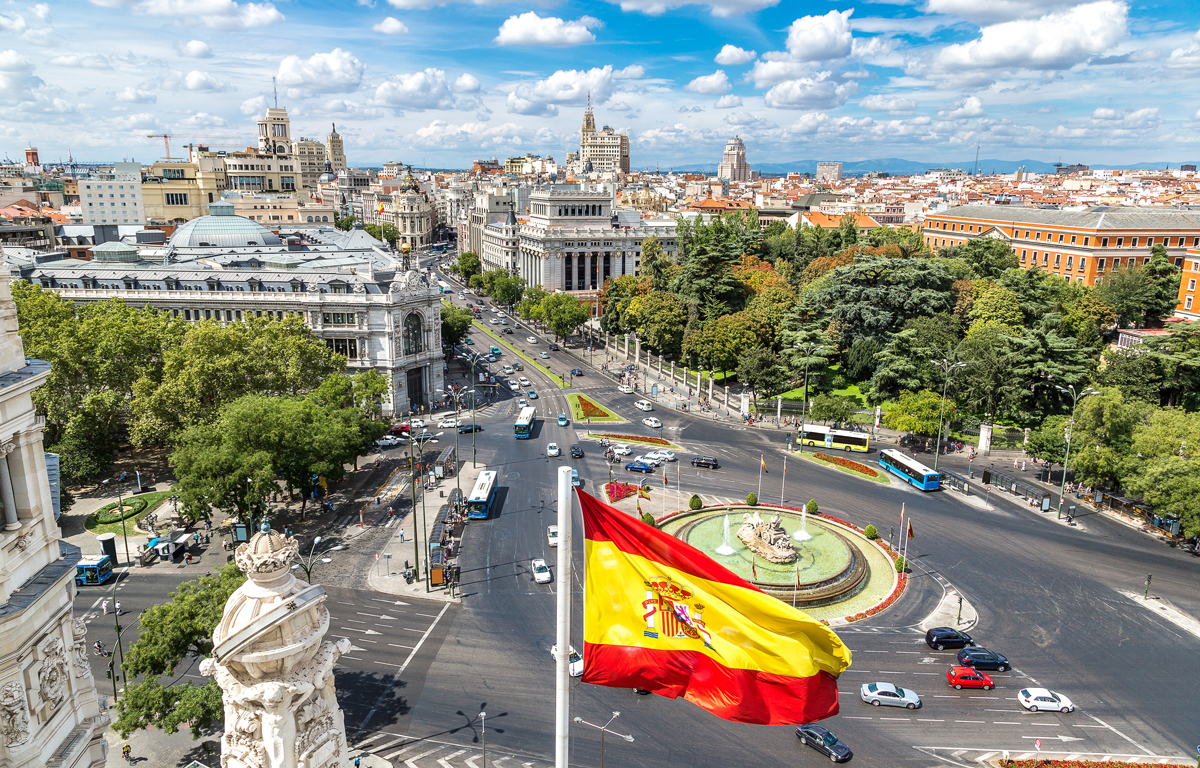Spain is Europe’s fourth-largest economy. Nevertheless, the country is mistakenly associated almost exclusively with the tourism sector. This indeed is one of the most important sectors of the economy. But Spain’s manufacturing industry and steadily increasing exports of goods should not be underestimated. The strong purchasing power also makes the country interesting for importers. In this blog post, we, therefore, want to take a look at the country away from the usual vacation clichés such as beaches, flamenco, and tapas and look at logistical peculiarities. What are the most important import and export goods, which transport modes and routes are particularly busy, and who are Spain’s most important trading partners? Why is it worthwhile to look at the Spanish market as a trader and how can the right freight forwarding partner support you with your logistics requirements to and from Spain? Let’s explore the country on the Iberian Peninsula logistically!
Spain: Import or Export Nation?
Spain is very open to foreign trade and has tended to be an import nation in recent years. Exports have increased sharply recently, but overall the trade balance is still in deficit. The reason for this is that exports did not grow at the same level as imports. This also has to do, above all, with the traded product groups, which we will talk about in the next section. In the first six months of 2021, imports reached a level of 186.524 million Euros, while the level of exports was 179.529 million Euros. Even after the Corona crisis, imports as a whole recovered faster than exports.
What are Spain's most important and/or most traded commodities?
In terms of imports, Spain trades most in capital goods, chemical products, energy sources, automotive parts and accessories, and consumer goods. As the country itself has only limited crude oil reserves, crude oil is the most important import commodity, accounting for 13.1% of total imports in 2021. Another important raw material – especially for the automotive sector – is steel. Spain is the world’s 14th largest customer for steel. For importers from the textile industry, it is certainly also interesting that Spain is the sixth largest customer for this group of goods. Even though the country itself is known for brands such as Zara, Desigual, and Mango, clothing forms the largest import category in the textile trade with a share of 78 percent.
Now to exports
When one thinks of Spain, the first thing that comes to mind is sun-ripened citrus fruits such as oranges and lemons. And in fact, Spain is the world leader in exporting lemons. Europe is supplied almost exclusively from here with the sour vitamin bombs. Spain is also the world’s leading exporter of another product that inevitably brings Spain to mind: (crude) olive oil. With the world’s largest area under cultivation, Andalusia in particular is known for the production of this liquid gold. In terms of sales, however, other goods are ahead: capital goods, beverages and tobacco, chemical products and vehicles, and vehicle parts account for the bulk of sales.
Spain is the second-largest automobile manufacturer in the EU, and various vehicle models are produced exclusively here. In 2021, however, exports declined because Spain’s automotive industry, including the supplier market, suffered from the global semiconductor shortage.
Good to know:
Due to disrupted supply chains in the wake of the Corona pandemic and the Ukraine war, the Spanish government provided €12 billion in funding in May 2022 to localize semiconductor manufacturing. The sum is part of a larger build-up and resilience plan to make Spain not only the largest eMobility producer in Europe but also to support further sustainability and digitalization investments. We will explain how sustainable and digital the country already is today in the rest of this blog post. But first, let’s look at Spain’s most important trade routes and partners.
Spain's most important trade lanes and trading partners
Of Spain’s exports, around 61.5% remain within the European Union. The most important trading partner for exports is Spain’s immediate neighbor France, with 15% of total exports, followed by Germany (10%), Italy, and Portugal (around 7% each). The United Kingdom follows in fifth place. Only in sixth place is an overseas state, the USA.
In 2021, more than half of the total volume of imports will come from non-EU countries. China is Spain’s largest non-European import partner, accounting for 10% of total imports. This puts China roughly on a par with France. The two countries are surpassed by only one country, albeit by just one percentage point, and that is Germany.
Good to know:
Spain has very good relations with the African continent due to its geographical location. Morocco and Nigeria are particularly noteworthy as trading partners. Thanks to linguistic, historical, and cultural proximity to the LATAM region, there is also a lively trade exchange with this part of the world. The most important partner here in Mexico.
By which modes of transport do goods arrive and leave Spain?
After looking at the “Where from” and “With whom”, it is time to take a look at the “How”. Spain’s infrastructure is excellently developed, and goods can be shipped in and out of the country quickly and efficiently via all modes of transport. For non-European imports, sea freight is undoubtedly the most important mode, while within Europe, road and rail are the most important modes of transport. But air freight should not be neglected either.
Sea Freight
With about 8,000 km of coastline (about 4,000 KM of which are on the mainland alone), Spain has access to both the Atlantic Ocean and the Mediterranean Sea. The ports of Barcelona, Valencia, and Algeciras are among the 100 largest in the world, making sea freight undoubtedly the most important mode of transport for trade with Asia and the Americas. 74% of all international trade enters and leaves Spain on container ships. The percentage is slightly higher for imports (74.9%) than for exports (72.8%). In particular, the port of Algeciras, located directly on the famous Strait of Gibraltar, is an important hub. Most recently (2021), it was voted Europe’s most efficient port and is even ranked 11th worldwide according to World Banks and S&P’s “The Container Port Performance Index” report.
Air Freight
Tonnage in the air cargo sector has increased sharply in recent years, both on the export and import sides. In 2019, the volume of transported goods in the Aena S.A. network amounted to more than 1,068,394 tons. Aena S.A. is Spain’s largest airport operator and also owns stakes in airports in Mexico, the United States, Cuba, Colombia, Bolivia, Sweden, and the United Kingdom. Most tonnage came to Spain from Europe (190,971 tons), more precisely from Germany. Most exports (203,295 tons) left Spain for the Americas, mostly headed for the USA. Aena’s figures show that even though the country is more of an importing nation, air freight seems to play a more important role for exports than for imports. Aena also operates Spain’s largest airport, Adolfo Suárez Madrid-Barajas (MAD). This is also the country’s most important logistics hub, as it handles the most cargo. Just recently, the airport operator announced that 47,172 tons of cargo were handled in May 2022, some 4.9% more than in the same month in 2019. The development is a post-pandemic ray of hope for the air cargo market.
Our Tip:
If you want to ship goods to or from Spain, you should also take a look at Belly’s capacities. Spain is the country with the most arrivals worldwide after France. Before the pandemic, up to 5,000 flights arrived in Spain every day. During peak tourist periods in the summer, the number is even higher. This gives you additional opportunities to transport your cargo.
Road and rail freight
Imports and exports within the European continent are largely transported by road. To be precise, around 78 % of all goods are transported by road within Europe. For domestic transport, the figure is as high as 95 %. Nevertheless, about 22 % of European transport is carried out by rail.
Good to know:
The share of rail freight is set to grow more strongly in the future if the EU has its way. Because while Spain has a very good and modern rail infrastructure that extends like a spider’s web from Madrid to the entire country, the use of this network in the freight sector is not yet very widespread. But it is not only the EU that is focusing on more sustainable modes of transport. Most recently, for example, IKEA has decided to switch from road to rail, using the greener alternative between the port of Barcelona and the Tarragona terminal. Many more companies are likely to opt for this move as part of their corporate social responsibility and sustainability goals.
Are there any country-specific regulations to be observed for logistics in Spain?
Spain is a member of the European Union and thus benefits from the free movement of goods in the EU’s internal market. The EU-wide regulations also apply accordingly to trade with third countries. For the export and import of goods outside the EU, business registration with the corresponding license is required. Registration in the Special Register of Foreign Trade Enterprises (REOCE) of the Ministry of Industry, Trade and Tourism grants a license for the export and import of materials, products, and technologies mentioned in Royal Decree 679/2014 of August 1. A distinction must be made between private individuals (natural persons) and companies (legal entities). Importers can apply online for import licenses at the Spanish Trade Secretariat. The application must be accompanied by
- Commercial invoices
- Freight costs
- Insurance costs
- CIF price
- net and gross weight
and an invoice number.
Once issued, the license is valid for six months, but may be renewed. Specific regulations depending on the country or type of goods can be found on the Ministry of Industry, Trade, and Tourism website.
Are there regional, seasonal and cultural specifics for trade with Spain?
The second largest country in the EU in terms of area is a parliamentary, constitutional monarchy. In addition to the mainland, the Balearic Islands in the Mediterranean and the Canary Islands in the Atlantic are part of the national territory. Despite the sheer size of the country, most people live in urban areas. A total of 49 UNESCO World Heritage Sites bear witness to the country’s endlessly rich history. In the following, we will take a look at some of the country’s typical features that you should keep in mind when importing and exporting.
Regional and cultural particularities
One of the most striking features is the different languages of the country. The official language is Spanish. Besides, there are some linguistic and regional differences in Spain. In addition to Spanish, Catalan (Català), Galician (Galego), and Basque (Euskara) are spoken to a not inconsiderable extent. Regions where these languages are spoken usually have a strong regional identity. But don’t worry, foreign importers should not have any communication problems. Almost all inhabitants of the country speak Spanish in addition to the regional languages.
Seasonalities in Spain's Logistics
For imports to Spain, regional festivities and holidays of the trading partners play a major role. For Spain, as for other EU countries, the most important partner is China. The peak season (September to December) therefore often coincides with Chinese New Year and Golden Week. Chinese factories, offices, ports, and airports remain closed. Transportation costs increase and capacities become scarce during this time. Timely planning is therefore essential. In addition to the peak season in the fall/winter months, June is also important for importers. Spain’s textile industry then prepares for the winter collections.
From the export point of view, the month of August is usually challenging. This is because then almost the whole country comes to a standstill. It is very hot and many Spaniards use the month for longer vacations. So it is not uncommon that for one or two weeks communication with local partners is challenging. Again, it is important to plan transportation well in advance.
Other significant vacation periods are Easter and Christmas.
What is Spain's level of digitization?
The pandemic has accelerated the digitization process in all companies, and Spain is no exception. Especially in small and medium-sized enterprises (SMEs), the willingness to digitize is very high. In a YouGov study commissioned by IONOS, the Spanish SMEs surveyed even attach more importance to digitization than their counterparts in Germany, France, or the USA. 88% of SMEs say digitization is very important to them because of their future viability.
... and in the logistics sector in Spain?
In the logistics sector, this insight may also exist in theory. However, another YouGov study, this time commissioned by Teamviewer, shows that in practice the industry is still in its infancy. Despite the pressure to digitize, only 33% of the logistics companies surveyed have begun to take appropriate measures for digital transformation. Conversely, this leads to 65% of Spanish companies complaining about a lack of transparency in their supply chains. One of the main reasons for this hesitancy is cost.
At least for SMEs, the Spanish government has planned appropriate programs and assistance, similar to those in the area of sustainability. As part of the comprehensive digital agenda DIGITAL SPAIN 2025, SMEs are to be supported with digital toolkits. The government has set itself the goal of increasing the share of e-commerce in the business activities of SMEs to 25%. Currently, this is just 10%.
How strong is public awareness of sustainability?
In contrast to Scandinavian countries such as Denmark, the topic of sustainability is not yet so firmly anchored in society in the Mediterranean region. Although there have been increasing efforts in recent years to raise awareness of sustainability issues, the impetus still comes predominantly from Spanish politics. Initiatives such as España Circular 2030, which focuses on a sustainable circular economy, or the Climate Change and Energy Transition Law, a law based on the Paris climate target agreement, are worth highlighting. The law aims to reduce greenhouse gas emissions in Spain by at least 23% by 2030 and increase the share of renewable energy in the electricity system by at least 74%. The most ambitious goal: before 2050, the country wants to become climate neutral. In contrast to the politicians, the business community is still a bit hesitant, which is why there are always government subsidies for companies that want to become greener. Large global players such as the aforementioned IKEA, as well as young, up-and-coming startups, are in some cases further ahead in terms of sustainability than local traditional companies and could become major drivers of Spain’s green transformation.
Conclusion: Why the Spanish market is so attractive for logistics
Spain is a cultural, historical, geographical, and culinary highlight. The country is rightly one of the most popular tourist destinations. However, the continuous increase in imports and exports also makes the country interesting for retailers. The e-commerce market in particular is growing rapidly. Exciting developments are also taking place in the automotive sector, which could make Spain a top global player in electromobility in the future.
As the country is very open to international trade, the import and export regulations are manageable. The trade routes and lanes are excellently developed and will become even better with extensive investments shortly. Numerous strategically located ports, highly frequented airports, and good connections to Central Europe and the African continent make for an almost seamless transportation experience.
Angel Hierro, Forto’s Director Iberia, explains why Spain is so exciting from a logistics perspective:
The only thing that can make imports and exports to and from Spain more difficult is the digitalization of the logistics industry, which has not yet been as pronounced. As a digital freight forwarder, Forto has therefore made it its mission to drive highly transparent and frictionless supply chains through technology-enabled logistics and transportation solutions.
Forto's proximity to the market and customers
With offices in Madrid and Barcelona as well as a dedicated team of experts, Forto is not only responding to the desire of many Spanish customers for more transparency in their supply chains. With the office in the heart of Madrid, which is powered by green electricity, Forto is also making a sustainability statement. In addition to digital, sustainable transformation is also part of Forto’s DNA. That’s why the company offers its customers climate-friendly logistics solutions.
For companies that would like to make their supply chains more digital and green, but don’t quite know where to start, Forto’s technology and logistics experts are always happy to answer questions. Contact us!












